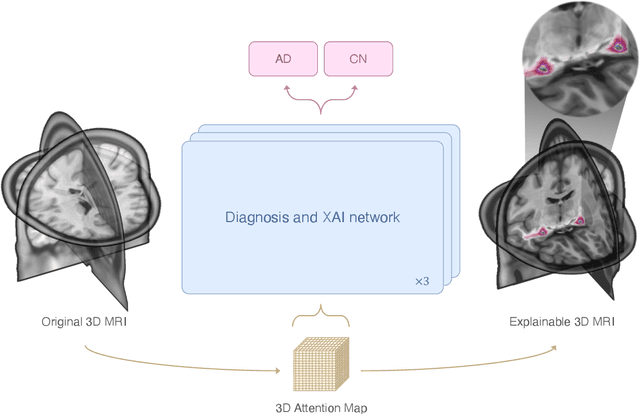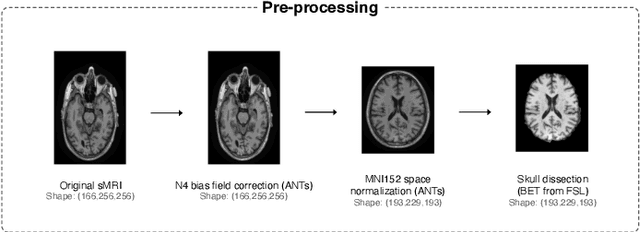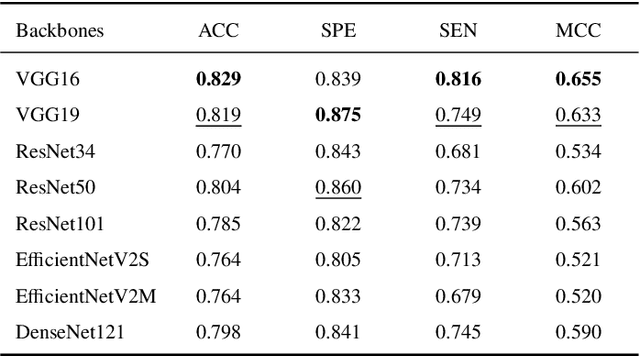Francesco Fontanella
Latent Diffusion Autoencoders: Toward Efficient and Meaningful Unsupervised Representation Learning in Medical Imaging
Apr 11, 2025Abstract:This study presents Latent Diffusion Autoencoder (LDAE), a novel encoder-decoder diffusion-based framework for efficient and meaningful unsupervised learning in medical imaging, focusing on Alzheimer disease (AD) using brain MR from the ADNI database as a case study. Unlike conventional diffusion autoencoders operating in image space, LDAE applies the diffusion process in a compressed latent representation, improving computational efficiency and making 3D medical imaging representation learning tractable. To validate the proposed approach, we explore two key hypotheses: (i) LDAE effectively captures meaningful semantic representations on 3D brain MR associated with AD and ageing, and (ii) LDAE achieves high-quality image generation and reconstruction while being computationally efficient. Experimental results support both hypotheses: (i) linear-probe evaluations demonstrate promising diagnostic performance for AD (ROC-AUC: 90%, ACC: 84%) and age prediction (MAE: 4.1 years, RMSE: 5.2 years); (ii) the learned semantic representations enable attribute manipulation, yielding anatomically plausible modifications; (iii) semantic interpolation experiments show strong reconstruction of missing scans, with SSIM of 0.969 (MSE: 0.0019) for a 6-month gap. Even for longer gaps (24 months), the model maintains robust performance (SSIM > 0.93, MSE < 0.004), indicating an ability to capture temporal progression trends; (iv) compared to conventional diffusion autoencoders, LDAE significantly increases inference throughput (20x faster) while also enhancing reconstruction quality. These findings position LDAE as a promising framework for scalable medical imaging applications, with the potential to serve as a foundation model for medical image analysis. Code available at https://github.com/GabrieleLozupone/LDAE
Poseidon: A ViT-based Architecture for Multi-Frame Pose Estimation with Adaptive Frame Weighting and Multi-Scale Feature Fusion
Jan 14, 2025Abstract:Human pose estimation, a vital task in computer vision, involves detecting and localising human joints in images and videos. While single-frame pose estimation has seen significant progress, it often fails to capture the temporal dynamics for understanding complex, continuous movements. We propose Poseidon, a novel multi-frame pose estimation architecture that extends the ViTPose model by integrating temporal information for enhanced accuracy and robustness to address these limitations. Poseidon introduces key innovations: (1) an Adaptive Frame Weighting (AFW) mechanism that dynamically prioritises frames based on their relevance, ensuring that the model focuses on the most informative data; (2) a Multi-Scale Feature Fusion (MSFF) module that aggregates features from different backbone layers to capture both fine-grained details and high-level semantics; and (3) a Cross-Attention module for effective information exchange between central and contextual frames, enhancing the model's temporal coherence. The proposed architecture improves performance in complex video scenarios and offers scalability and computational efficiency suitable for real-world applications. Our approach achieves state-of-the-art performance on the PoseTrack21 and PoseTrack18 datasets, achieving mAP scores of 88.3 and 87.8, respectively, outperforming existing methods.
AXIAL: Attention-based eXplainability for Interpretable Alzheimer's Localized Diagnosis using 2D CNNs on 3D MRI brain scans
Jul 02, 2024



Abstract:This study presents an innovative method for Alzheimer's disease diagnosis using 3D MRI designed to enhance the explainability of model decisions. Our approach adopts a soft attention mechanism, enabling 2D CNNs to extract volumetric representations. At the same time, the importance of each slice in decision-making is learned, allowing the generation of a voxel-level attention map to produces an explainable MRI. To test our method and ensure the reproducibility of our results, we chose a standardized collection of MRI data from the Alzheimer's Disease Neuroimaging Initiative (ADNI). On this dataset, our method significantly outperforms state-of-the-art methods in (i) distinguishing AD from cognitive normal (CN) with an accuracy of 0.856 and Matthew's correlation coefficient (MCC) of 0.712, representing improvements of 2.4\% and 5.3\% respectively over the second-best, and (ii) in the prognostic task of discerning stable from progressive mild cognitive impairment (MCI) with an accuracy of 0.725 and MCC of 0.443, showing improvements of 10.2\% and 20.5\% respectively over the second-best. We achieved this prognostic result by adopting a double transfer learning strategy, which enhanced sensitivity to morphological changes and facilitated early-stage AD detection. With voxel-level precision, our method identified which specific areas are being paid attention to, identifying these predominant brain regions: the \emph{hippocampus}, the \emph{amygdala}, the \emph{parahippocampal}, and the \emph{inferior lateral ventricles}. All these areas are clinically associated with AD development. Furthermore, our approach consistently found the same AD-related areas across different cross-validation folds, proving its robustness and precision in highlighting areas that align closely with known pathological markers of the disease.
A Machine Learning Approach to Analyze the Effects of Alzheimer's Disease on Handwriting through Lognormal Features
May 27, 2024Abstract:Alzheimer's disease is one of the most incisive illnesses among the neurodegenerative ones, and it causes a progressive decline in cognitive abilities that, in the worst cases, becomes severe enough to interfere with daily life. Currently, there is no cure, so an early diagnosis is strongly needed to try and slow its progression through medical treatments. Handwriting analysis is considered a potential tool for detecting and understanding certain neurological conditions, including Alzheimer's disease. While handwriting analysis alone cannot provide a definitive diagnosis of Alzheimer's, it may offer some insights and be used for a comprehensive assessment. The Sigma-lognormal model is conceived for movement analysis and can also be applied to handwriting. This model returns a set of lognormal parameters as output, which forms the basis for the computation of novel and significant features. This paper presents a machine learning approach applied to handwriting features extracted through the sigma-lognormal model. The aim is to develop a support system to help doctors in the diagnosis and study of Alzheimer, evaluate the effectiveness of the extracted features and finally study the relation among them.
How word semantics and phonology affect handwriting of Alzheimer's patients: a machine learning based analysis
Jul 06, 2023Abstract:Using kinematic properties of handwriting to support the diagnosis of neurodegenerative disease is a real challenge: non-invasive detection techniques combined with machine learning approaches promise big steps forward in this research field. In literature, the tasks proposed focused on different cognitive skills to elicitate handwriting movements. In particular, the meaning and phonology of words to copy can compromise writing fluency. In this paper, we investigated how word semantics and phonology affect the handwriting of people affected by Alzheimer's disease. To this aim, we used the data from six handwriting tasks, each requiring copying a word belonging to one of the following categories: regular (have a predictable phoneme-grapheme correspondence, e.g., cat), non-regular (have atypical phoneme-grapheme correspondence, e.g., laugh), and non-word (non-meaningful pronounceable letter strings that conform to phoneme-grapheme conversion rules). We analyzed the data using a machine learning approach by implementing four well-known and widely-used classifiers and feature selection. The experimental results showed that the feature selection allowed us to derive a different set of highly distinctive features for each word type. Furthermore, non-regular words needed, on average, more features but achieved excellent classification performance: the best result was obtained on a non-regular, reaching an accuracy close to 90%.
 Add to Chrome
Add to Chrome Add to Firefox
Add to Firefox Add to Edge
Add to Edge